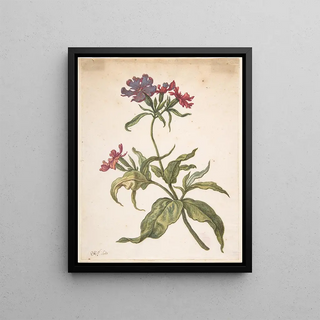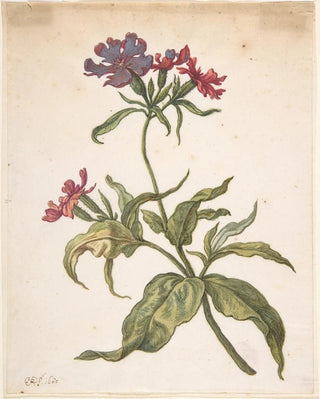Art print | Study of a red campion Lychnis hirsuta - Herman Saftleven Source: Reproduction | Étude d'un silène rouge Lychnis hirsuta - Herman Saftleven


View from behind

Frame (optional)
Herman Saftleven’s artwork "Study of a Red Lychnis Hirsuta" is an invitation to immerse oneself in the delicate universe of nature, revealing the ephemeral beauty of flowers through the lens of artistic talent. This art print, faithful to the original, captures the very essence of botany while offering a reflection on the fragility of life. Contemplating this piece, the viewer is transported to a secret garden where each petal, each shade of red, evokes a deep and timeless emotion. Light plays a crucial role, illuminating details with a precision that testifies to Saftleven’s craftsmanship. Thus, this piece is not merely a simple representation but becomes an immersive experience that stimulates the imagination and invites contemplation.
Style and uniqueness of the artwork
Saftleven’s style is distinguished by its ability to blend realism and expressionism, creating a visual harmony that captivates the eye. In "Study of a Red Lychnis Hirsuta," the delicate contours of the flowers are rendered with remarkable meticulousness, while vibrant colors breathe life into each element. The artist employs chiaroscuro techniques to enhance volume and texture, making the flowers almost tangible. This attention to detail, combined with a rich and warm palette, gives the artwork an almost tactile dimension. The composition, though simple in its subject, reveals a depth that encourages prolonged observation. Each glance at this piece uncovers new subtleties, as if the red lychnis, in its splendor, tells a story at every moment.
The artist and his influence
Herman Saftleven, a Dutch painter of the 17th century, is often recognized for his mastery of still life and botanical studies. His career, though less well-known than those of his contemporaries, has nonetheless left an indelible mark on the art world. Influenced by the Baroque movement, Saftleven was able to capture the fleeting beauty of nature, transforming ordinary subjects into true masterpieces. His innovative approach, blending scientific observation and sensitivity

Matte finish

View from behind

Frame (optional)
Herman Saftleven’s artwork "Study of a Red Lychnis Hirsuta" is an invitation to immerse oneself in the delicate universe of nature, revealing the ephemeral beauty of flowers through the lens of artistic talent. This art print, faithful to the original, captures the very essence of botany while offering a reflection on the fragility of life. Contemplating this piece, the viewer is transported to a secret garden where each petal, each shade of red, evokes a deep and timeless emotion. Light plays a crucial role, illuminating details with a precision that testifies to Saftleven’s craftsmanship. Thus, this piece is not merely a simple representation but becomes an immersive experience that stimulates the imagination and invites contemplation.
Style and uniqueness of the artwork
Saftleven’s style is distinguished by its ability to blend realism and expressionism, creating a visual harmony that captivates the eye. In "Study of a Red Lychnis Hirsuta," the delicate contours of the flowers are rendered with remarkable meticulousness, while vibrant colors breathe life into each element. The artist employs chiaroscuro techniques to enhance volume and texture, making the flowers almost tangible. This attention to detail, combined with a rich and warm palette, gives the artwork an almost tactile dimension. The composition, though simple in its subject, reveals a depth that encourages prolonged observation. Each glance at this piece uncovers new subtleties, as if the red lychnis, in its splendor, tells a story at every moment.
The artist and his influence
Herman Saftleven, a Dutch painter of the 17th century, is often recognized for his mastery of still life and botanical studies. His career, though less well-known than those of his contemporaries, has nonetheless left an indelible mark on the art world. Influenced by the Baroque movement, Saftleven was able to capture the fleeting beauty of nature, transforming ordinary subjects into true masterpieces. His innovative approach, blending scientific observation and sensitivity






